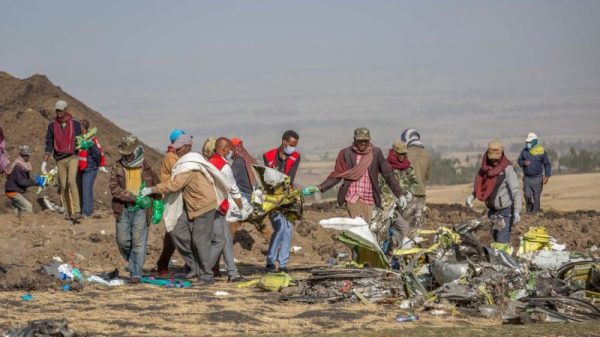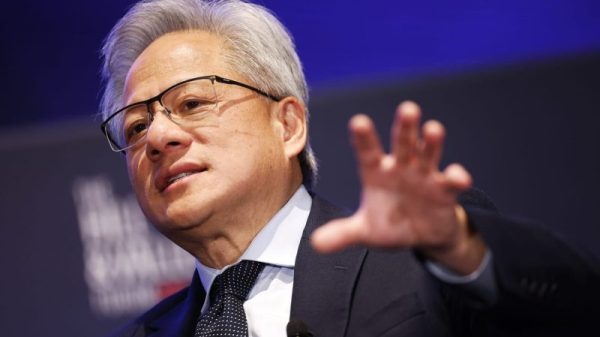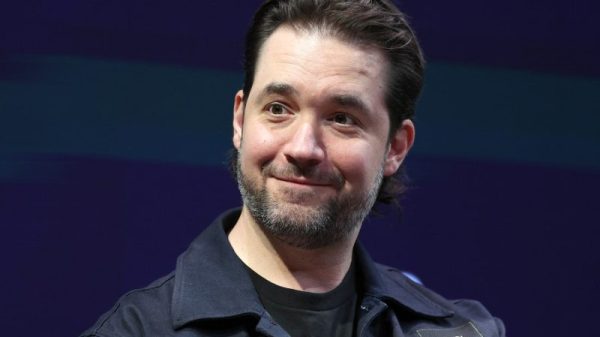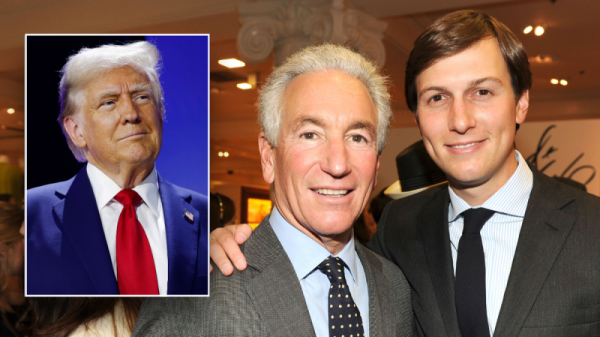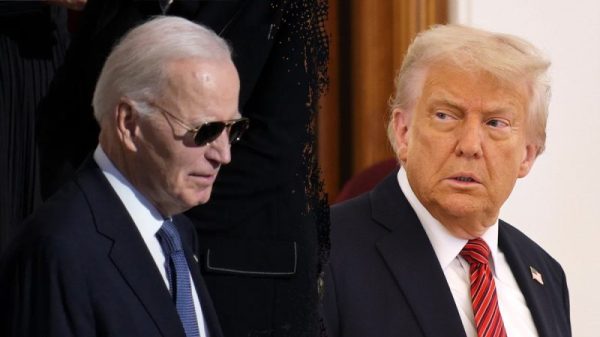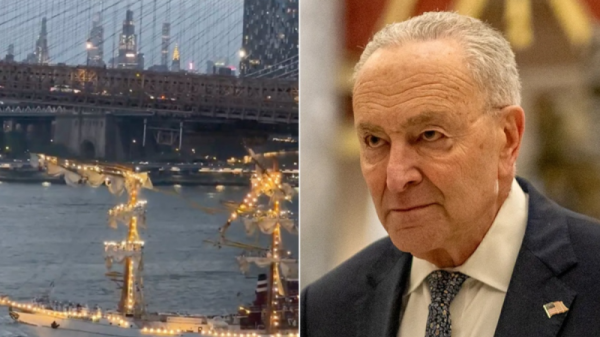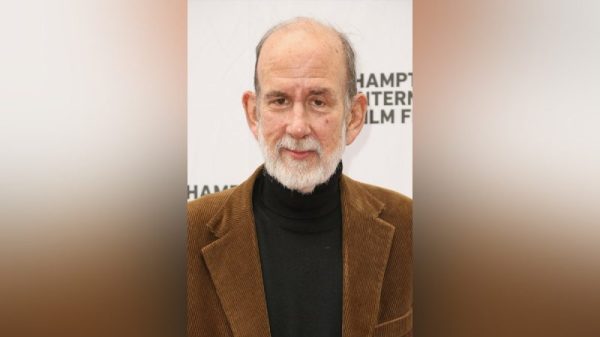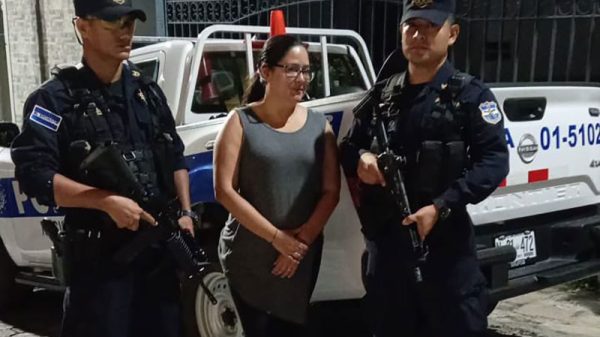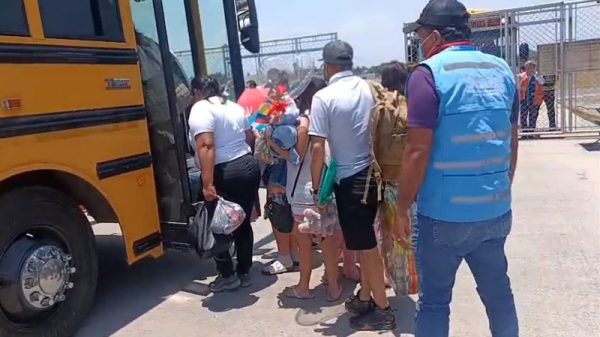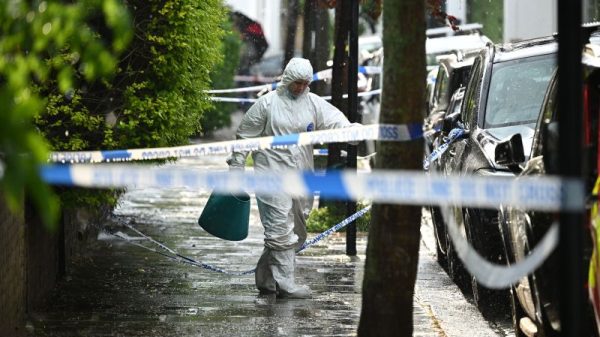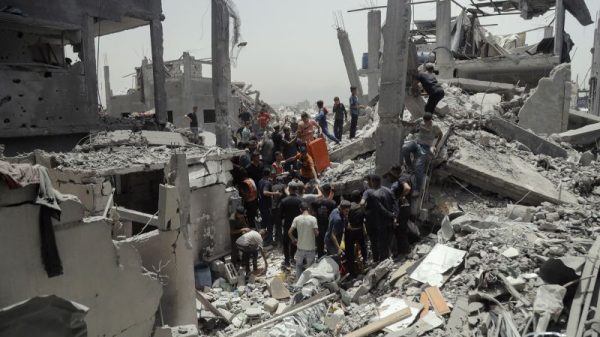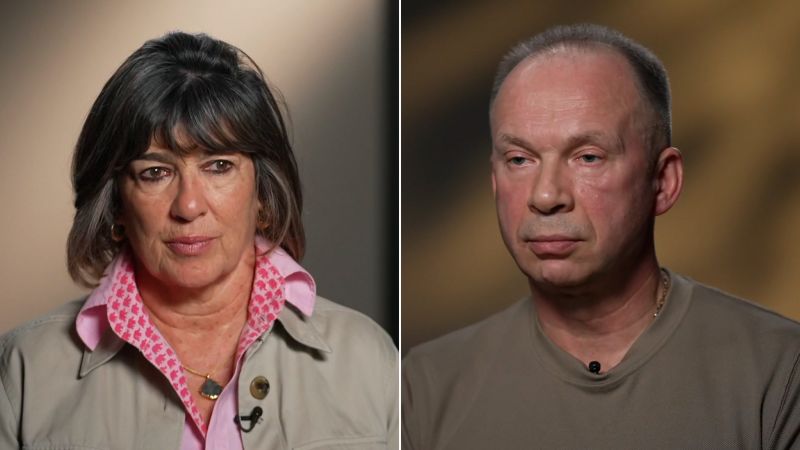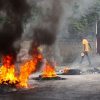AMANPOUR: General Syrskyi, welcome to the program.
SYRSKYI: [In English] Thank you very much.
AMANPOUR: So it’s great to be able to talk to you. It’s the first time you’re doing an interview on television. And I want to know why you think there’s such an uptick in the war against this country right now. Russian ballistic missiles just in one week alone in Lviv killed, you know, nearly 10 people. In Poltava, more than 50 people. Strikes all across the country.
SYRSKYI: [In Ukrainian] I believe that Russia is trying to force us to give up and break our will to resist by hitting our civilian objects and damaging civilian infrastructure. By targeting our civilians in this way, they are trying to break our will to win.
AMANPOUR: I want to ask you about Kursk, because I know that you spend time there, near the frontlines. And I know that you and President Zelensky came up with this operation. Tell me from your words and your view, what was the strategic purpose of the Ukrainian operation into Russian Kursk?
SYRSKYI: First, the enemy, Russian troops, had previously intended to use the Kursk direction as a foothold for further operations against our troops. On May 10, they launched an offensive in the Kharkiv direction, and just a few days later they planned to strike and advance in the Sumy direction by using the Kursk direction and the territories of the Kursk region as a springboard for further actions against our state, against our armed forces there.
Having suffered losses in the Kharkiv sector, they literally got stuck in their offensive and actually moved to the defense in Vovchansk. They stopped in the area of Hlyboke, in the area of Lyptsi. And the troops that went on the offensive in the Kharkiv direction were no longer enough. Then they gradually began to redeploy those units that were located in the Kursk region, in the Sumy direction, to the Kharkiv direction.
Thus, the offensive in the Sumy direction did not take place. But they continued to consider this direction, this springboard for further actions of their own. In addition, they continued to shell our settlements daily, which caused us to suffer losses, primarily among the civilian population. This lasted until May, and in May there was a significant intensification. It was already clear then that this delay was temporary.
For us, this direction was always a threat. Therefore, in assessing our capabilities, we chose the weakest point in the enemy’s defense, in the enemy’s structure. And this direction was chosen. This reduced the threat of an enemy offensive. We prevented them from acting. We moved the fighting to the enemy’s territory so that he could feel what we feel every day. And we created our own security zone in the Kursk region. In addition, we took a sufficient number of prisoners. We created an “exchange fund” in order to release our military personnel who are in captivity.
AMANPOUR: Some of your – for instance, your defense minister has said publicly that the reason was to divert Russian forces from other parts of the eastern front. But there are others on the eastern front, commanders, who say it hasn’t diverted enough forces, and there’s still a lot of pressure on your forces on the eastern front – that important logistical hub of Pokrovsk. So has it been strategically a success, and even tactically a success, what you’ve done in Kursk? And do you think you might lose Pokrovsk?
SYRSKYI: We are doing everything we can not to lose Pokrovsk. We are strengthening our defenses there. Over the past six days, the enemy has not advanced a single meter in the Pokrovsk direction. So our strategy is working. Of course, the enemy has concentrated the most trained of its units in the Pokrovsk sector. But we have deprived him of the ability to maneuver his units and the ability to redeploy his strengthening units from other areas.
So, in fact, it turns out that even though they did not move many troops from the Pokrovsk area except for one marine brigade, they are now unable to manoeuvre their reserves as they used to. And this weakening is actually felt in other areas. We note that the number of artillery attacks and the intensity of offensive actions have decreased. In fact, the Pokrovsk direction remains the most problematic for us. In other areas, the situation has become more stable. So I think this strategy was chosen correctly and it will bring us the desired result.
AMANPOUR: Can I ask you about the obvious imbalance, and that is, essentially Ukraine, while you’re fighting hard, you are outgunned by the Russians. They have much more air superiority, for instance, more drones, they have more missile capability, they have more artillery capability. How do you assess the difference between what you have and what they have? And how do you make up for that difference?
SYRSKYI: You are absolutely right, because the enemy does have an advantage in aviation, in missiles, in artillery, in the amount of ammunition they use, of course – in personnel, tanks, and infantry fighting vehicles. But this also motivates us. We cannot fight in the same way as they do, so we must use, first of all, the most effective approach, use our forces and means with maximum use of terrain features, engineering structures. And also to use technical superiority.
First of all, by focusing on high-tech weapons. These are primarily unmanned aerial systems for various purposes. You know that we have created the world’s first such kind of troops as the Unmanned Systems Forces. We have created a command, we have created units, we have created regiments, we have created battalions, which are now proving their effectiveness in various parts of the frontline. Our best unmanned systems units are concentrated in the Pokrovsk sector.
In addition, of course, we use maneuvers with force, reserves, and fire. Thanks to the actions of our government, the president of Ukraine, the minister of defense, we managed to reduce the difference between the ammunition used by us and the enemy. The proportion is actually one to two, one to two-and-a-half. A year ago, this figure was one to ten, one to six. We compensate for this difference with unmanned systems. We are constantly working on improving them, increasing their efficiency, improving the control system, ways and methods of usage. We are trying to maximize our technical superiority over the enemy to offset their superiority in terms of numbers.
AMANPOUR: You obviously have much, much less manpower than they do. The Russians have such a huge advantage of manpower over you. I think now they have something like more than half a million people under arms. At the beginning of the full-scale invasion, they had a hundred thousand. It’s thought that they may have 700,000 by the end of this year. And you said when you took this job that one of the issues that you have to do is make sure you can replenish your ranks – draft, whatever it is, get more, more, more Ukrainians to fight. How is that going? Are you satisfied, or not?
SYRSKYI: In general, we manage to maintain our mobilisation capabilities at the appropriate level and ensure both replenishment of losses and training of new units. That is, thanks to the coordinated work of all state authorities, military bodies, primarily territorial recruitment centres, we maintain these performance levels and ensure the replenishment of our military units.
SYRSKYI: You are right on this point. The issue of morale is a very important area of our work. And, of course, we are talking about the Kursk operation again. This was a factor that significantly improved the morale of not only the military but the entire Ukrainian population. That is, it was and still is an incentive that has boosted the morale of our servicemen, their desire to win. This is first of all.
Secondly, regarding training: of course, everyone wants the level of training to be the best, so we train highly qualified, professional military personnel. At the same time, the dynamics at the front require us to put conscripted servicemen into service as soon as possible. That is why we usually conduct basic military training for at least a month, and qualified training from half a month to a month. Thus, our soldiers are trained for a month and more – up to two months. In the long term, we are considering increasing this period and this will give us certain advantages.
And now we focus primarily on the professionalism of our instructors, on building up our training and material base, our training centers, and using training schools where servicemen acquire advanced skills in mastering weapons and related equipment. This is also probably the main activity of the ground forces, airborne assault forces and other types of troops, which are aimed at training qualified specialists who take part in combat operations.
AMANPOUR: I want to know – I mean, you as commander, do you go to the frontlines? Do you go to the trenches? Do you talk to soldiers there, and commanders? What do they say to you? Because I know some of them have been there for, you know, more than two years. They barely get rotation, they don’t get to see their family, there are these glide bombs, these terrifying things, I mean, drones, there’s just so much. I mean, it’s almost, it’s almost World War I kind of, you know, attacks on them in the trenches. And they’re there for a long time, with no real hope of rotation. What do they say to you when you go to see them and talk to them?
SYRSKYI: We speak the same language. We understand each other no matter who I am talking to, whether it is an ordinary soldier, a rifleman, for example, or a brigade commander or a battalion commander. You know that I have been in this war since 2014. Since the beginning of the full-scale aggression, I have actually been participating in combat operations as the commander of the operational and strategic group. Now I am the Commander-in-Chief of the Armed Forces of Ukraine. That is, the frontline is my life. We understand each other, I know all the problems that our servicemen, soldiers, and officers experience.
Despite the difficult situation, we continue to carry out rotations. We didn’t stop this process even when Avdiivka was happening – when there were, perhaps, more difficult times. The issue of rotations remains a priority for us. Of course, people get exhausted and need rest. That is why the units are either withdrawn to the rear for rest or sent to training centers, where they spend a month or a month-and-a-half recuperating. In this way, people restore their combat capabilities, their moral and mental state, and get the opportunity to visit their families and friends.
AMANPOUR: You became the overall commander at about the time that the US Congress finally approved, you know, the tranche of weapons and help that they’d promised you. It was a delay of six to seven months. What material difference did that make to your fight – the fact that these weapons were delayed for so long?
SYRSKYI: Of course, this has had a negative impact. When there is nothing to shoot with, no one and nothing to hold back the enemy, first of all, it leads to an increase in the level of losses, an increase in our losses not only in material resources, but also in human resources. Because the highest value in the Ukrainian army is the life of a soldier. It is very painful for us and of course it is painful to see that the losses of soldiers are increasing.
Well, the effectiveness of the use of troops is also extremely reduced, because when you have nothing to shoot with, you cannot hit the enemy efficiently and effectively. And this leads to the loss of territory. So how can this affect us? Of course, negatively.
AMANPOUR: And has it made a significant difference that the weapons have started to come now?
SYRSKYI: Of course, this has led to significant changes. But we would like to see these weapons arrive sooner. Because, unfortunately, this process is happening, but it is happening with a delay. This is also a negative for us. Especially when it comes to the formation of new units or when a unit is formed and there is no equipment, no weapons, how should we perceive it? You plan to use a mechanized brigade, but in fact you use it as an infantry brigade. As a result, its combat capabilities and effectiveness are much lower.
AMANPOUR: And obviously your ministers, your president are really appealing to the United States especially to stop restrictions on how you can use the weapons that do get here. What would you do with these weapons, if there were no restrictions on them? How would you use them?
SYRSKYI: We have repeatedly declared how we are going to use them. Of course, we will use weapons only against military targets, primarily against missile systems that strike populated areas almost daily. This leads to the loss of civilian lives. You know how many schools and hospitals have been destroyed in Ukraine, including Okhmatdyt, a well-known hospital. In fact, it was destroyed in the center of Kyiv by Russian cruise missile strikes. We have such cases every day. Not only adults but also children are killed. And the latest strikes on Poltava, Kharkiv, Sumy – in fact, there is not a single city in Ukraine that has not felt or suffered these losses. This horror of war, wherever you go, we have the results of these strikes, destroyed buildings, schools, and kindergartens.
So for us, first and foremost, it is a fight against the enemy’s missile weapons. Of course, it is the hitting of their warehouses, bases where weapons are stored, where fuel for the army is stored. Of course, this is all their logistics, which ensures the transfer of these weapons to the frontline.
Of course, these are the airfields from which the strike aircraft of the Russian army, their Aerospace Forces, use missile weapons, use their guided aircraft bombs with gliding modules, which they drop to 70 kilometres, even more. And again, they hit schools and populated areas. These are the targets. Of course, we will use [long-range weapons] against this [such targets]. We are not fighting against civilians, we are fighting against the Russian army.
AMANPOUR: You’ve been calling for a long time for fighter jets and F-16s to be able to not only take the fight to the targets, but also to intercept cruise missiles and others. There’s been an F-16 crash. Can you tell us what was the cause of that crash?
SYRSKYI: Firstly, I want to say that our pilots have been trained. They were trained in the educational institutions of our partner countries, and of course, the best pilots were selected who already had experience in effectively using the aircraft that are in service with the Ukrainian armed forces. Of course, they came highly trained, as our partners also confirmed, and received all the approvals to operate these aircraft.
Now a special commission of the Ministry of Defence is conducting an investigation to find out all the facts of the catastrophe, the crash of this aircraft. But before that, I want to say that the pilot who died, he shot down two missiles and he was just attacking, chasing the third cruise missile, using on-board weapons.
I think the results of the investigation will be known to everyone shortly. And on the one hand, we are not going to hide it, but on the other hand, the effectiveness of the use of these aircraft has been proven by the results – the destruction of four cruise missiles by a pair of F-16s, so this will certainly strengthen our defence capabilities, first of all in the fight against enemy cruise missiles.
AMANPOUR: There was word that it could be friendly fire. Do you think it was friendly fire?
SYRSKYI: You know, I can’t comment on something where there is no result yet.
AMANPOUR: Do you have restrictions on how you can use the F-16s that you have? And not many are in combat, right? I mean, one, two. How many are you using right now and do you have restrictions on them?
SYRSKYI: You know, I wouldn’t talk about quantity, I would talk about quality and how we use it. We use this modification of the F-16 as an interceptor and fighter aircraft. It is designed for this purpose and has the appropriate equipment and weapons. We, of course, train our pilots and they train every day, they are preparing to act against various types of enemy air attacks. Therefore, it is during these training sessions it’s been clarified this is its main purpose – to fight against enemy cruise missiles. And, of course, with enemy aircraft, if they can fly over the line of contact.
AMANPOUR: General Syrskyi, you were head of land forces during the initial part of the invasion in 2022. And you were created Hero of Ukraine by the president for successfully repelling the Russian attempt to take Kyiv and you lifted the siege. Do you think there was a moment then, in early April, where the dynamic – well, it did change, but could have changed? Was there a moment that, maybe a missed opportunity to really end this war then?
SYRSKYI: It is difficult to answer this question. It was an opportunity to push back the enemy, an opportunity to break the myth of the Russian army’s invincibility. Despite the fact that there were not many units in Kyiv and the bulk of these troops were consolidated units, these were units created from cadets, from training units, and training centers. It is precisely their competent and thoughtful use, the use of maneuver, the use of maximum artillery capabilities, tank fire capabilities, primarily maneuver and mobile operations, that have shown that even with small forces and the right tactics, victories can and do come, both small and more significant.
And most importantly, you should always look for the centre of gravity, i.e. the weakest point in the [enemy’s] defence. You may recall what one of the Georgian military theorists called the cascading destruction of the enemy’s defences. This is exactly what happened near Kyiv, and it also happened near Kharkiv, when, at what seemed to be the height of the enemy’s offensive, it was hit with a spot attack that caused its defences to crumble, which significantly affected the further course of the war.
AMANPOUR: And finally, after successfully pushing the Russians back from Kyiv, and then there was, you know, the success in Kharkiv, and success in Kherson – since then, it’s been much more difficult and you haven’t done as much as you perhaps were expected to do. What do you expect? How do you expect the war to go for Ukraine over the next six months, for instance?
SYRSKYI: It is difficult to predict for such a long period of time, but of course we plan combat operations, we plan campaigns, we make appropriate calculations of our capabilities, the capabilities of the armed forces, our needs. And of course, we are committed to victory. And the help of our partners, our allies, would help us a lot. It would help us a lot if all restrictions on the use of weapons on the territory of the Russian Federation against military targets – I repeat, not against the civilian population, against military targets – were lifted.
The planned deliveries of weapons and equipment would allow us to bring our new brigades, which have already been formed and are in the process of being formed, into service as soon as possible. Of course, this would have an impact on the overall level of our capabilities.
That’s how I see it. That is, only in the fight can we win. And we are all determined to win. And again, the Kursk operation showed that victory is the incentive that boosts the morale of our military and our entire population. That’s the only way to do it and no other way.
AMANPOUR: General Oleksandr Syrskyi, thank you so much for joining us.
SYRSKYI: I thank you as well, it was a very interesting conversation. Now, if we’re about to finish, then of course I would like to extend words of gratitude to all of our partners for the assistance, for the support, the political, the logistical, the material support that’s provided to us on a daily basis. We clearly understand that we’re not left alone, that only together we can be victorious, and I’m grateful to everyone, because together we’re stronger. [IN ENGLISH] Together we can win.
AMANPOUR: Together we can win. That’s really a good way to end. Thank you so much.
SYRSKYI: [In English] We have to win.
AMANPOUR: You have to win?
SYRSKYI: [In English] Yeah.
AMANPOUR: Thank you, General Syrskyi.






